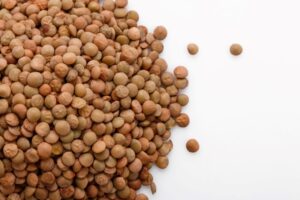Pardina Lentils
Pardina lentils are a versatile and delicious legume that have gained popularity in recent years for their unique flavor and texture. Small, nutty lentils hold shape after cooking. Cook in 30 mins, ideal for busy cooks.
Pardina lentils have dark, speckled seed coats and yellow cotyledons, with a size range of 32 to 35 grams per 1000 kernels. Mediterranean and Spanish cuisines often feature them in dishes such as stews, salads, and soups. Pardina lentils are a tasty and healthy pantry staple.
Key Takeaways
- Pardina lentils are small, versatile legumes with a nutty flavor and firm texture.
- They hold their shape well after cooking, ideal for salads and reheatable dishes.
- Pardina lentils are quick-cooking, ready in 30 minutes, and popular in Mediterranean and Spanish cuisine.
Pardina Lentils Overview
As a lentil enthusiast, I’m always intrigued by the different varieties of lentils available in the market. One of my personal favorites is Pardina lentils, also commonly known as Spanish Brown Lentils. These lentils are small, greenish-brown, and feature a dark speckled seed coat with yellow cotyledons. Pardina lentils have a unique nutty taste and size.
One of the qualities that I particularly appreciate about Pardina lentils is their ability to hold their shape well after cooking. This makes them perfect for use in salads and soups that need reheating. No soaking required, cook in 30 mins.
When cooking Pardina lentils, it’s essential to rinse the lentils with fresh water before boiling. Simmer one cup lentils with 2.5 cups liquid.After approximately 30 minutes, I check for the desired doneness and add salt to taste.
Store dried Pardina lentils in cool, dry place. Store Pardina lentils for long-lasting versatility.
In summary, Pardina llentils prove to be a fantastic addition to my pantry, with their unique flavor, short cook time, and ability to retain their shape. They work exceptionally well in salads, soups, and other dishes that require reheating.
Nutritional Value
Protein and Fiber Content
As a nutritious legume, Pardina lentils are a great source of plant-based protein and dietary fiber.1/4 cup has 160 calories, 13g protein, and 8g fiber. High protein and fiber content aid balanced diet.
Mineral Content
Along with their protein and fiber content, Pardina lentils are also rich in essential minerals, such as iron and magnesium. These minerals can help support a variety of bodily functions and maintain overall health. Eating Pardina lentils can be a beneficial way to get these necessary nutrients from a plant-based source.
In conclusion, incorporating Pardina lentils into my diet can provide essential nutrients to maintain better health. With their high protein, fiber, and mineral content, they make a versatile and delicious addition to various meals.
Preparation Methods
Rinsing and Soaking
Before cooking the lentils, it’s essential to rinse them thoroughly. I place the lentils in a mesh strainer and run them under cold water to rinse off any dirt or debris. Soaking Pardina lentils reduces cook time and aids digestion.
To soak the lentils, I add them to a large bowl, cover them with cold water, and let them sit for a few hours or even overnight. After soaking, I drain the lentils and discard the soaking water before cooking.
Cooking Time
Pardina lentils cook fairly quickly compared to other types of lentils such as brown lentils. Their small size and firm texture make them an excellent choice for dishes that call for a shorter cooking time.
When I cook Pardina lentils on the stovetop, I combine 1 cup of lentils with 2¼ cups of water, and a pinch of salt, if desired. I bring the mixture to a boil, then cover and simmer for about 25 to 30 minutes. I make sure to check occasionally to ensure they are cooked to my desired level of tenderness.
Another alternative I often use is the Instant Pot. Cooking lentils in an Instant Pot is a fast and efficient method. The cooking time varies depending on the pressure setting, but typically it takes around 10 minutes on high pressure with a natural release.
Once cooked, I drain any excess water if needed and use the Pardina lentils in various dishes. They hold their shape well and offer a delightful, nutty flavor that pairs well with rice, pasta, and sautéed vegetables.
Storage Tips
Cool and Dry Storage
I always store my Pardina lentils in a cool and dry place to ensure they maintain their quality and shelf life. If you don’t have a designated cool and dry spot in your home, consider finding a dark cabinet, pantry, or an area away from direct sunlight and fluctuating temperatures.
When storing Pardina lentils, it is important to sort through them and remove any debris, such as stones or damaged lentils. This not only helps maintain the quality of your lentils but also ensures a pleasant cooking and eating experience.
While storing lentils, I prefer using airtight containers to keep them fresh and protect them from moisture, pests, or any external contaminants. Using BPA-free, airtight containers can help maintain their quality and extend their shelf life 1.
Storing lentils for an extended period may cause them to lose their firm texture and become less flavorful. To maintain their firmness and flavor, it is advisable to consume lentils within a year that they were harvested.
Finally, refrigerating Pardina lentils may not be necessary, as a cool and dry storage environment is generally sufficient for preserving their quality. If you live in a high-humidity area or your lentils have become soft, you can consider refrigerating them. Just make sure to store them in an airtight container.
By following these storage tips, you can enjoy delicious and nutritious Pardina lentils throughout the year, and ensure you’re making the most of this versatile legume.
Purchasing Guidelines
Selecting Quality Lentils
When I am purchasing Pardina lentils, there are a few important aspects I take into consideration. The first thing I look for is the shape and firmness of the lentils. High-quality Pardina lentils should retain their shape during cooking, which helps them stand out from other varieties of lentils, like green, red, and yellow lentils.
I also pay attention to the size of the lentils. Pardina lentils are typically smaller than black lentils, so ensure that you are getting the correct variety. The color of Pardina lentils can range from brown to dark brown, with a slightly nutty flavor.
Additionally, I like to make sure I buy Pardina lentils from a reputable supplier to ensure they maintain quality standards. Purchasing in smaller quantities can ensure the lentils are fresh and offer the best taste and texture.
Origins and Varieties
As a legume enthusiast, I have always been interested in the diverse world of lentils. There are various kinds of lentils, including green, red, brown, black, and yellow. Pardina lentils, in particular, have caught my attention due to their unique characteristics and history.
First off, let me tell you about the origins of Pardina lentils. They have a strong connection with Spain, specifically the Castilla y León region, where they are produced in large quantities (source). The protected geographical indication (PGI) “Lenteja de Tierra de Campos” signifies the high-quality Pardina lentils originating from this area. While these Spanish lentils hold a distinctive place in the lentil family, it is also important to acknowledge that lentils have a long history and a wide range of varieties.
Speaking of the diverse world of lentils, let me take you through some of the major types. Green lentils are popular globally and have a mild peppery taste. They retain their shape well after cooking and are great in salads and side dishes. Red lentils, on the other hand, cook relatively quickly and have a sweet, nutty flavor. These are popular in Indian and Middle Eastern cuisines, often used in dishes like dal or curry.
Yellow lentils resemble red lentils in taste and texture but are, as the name suggests, yellow in color. They are widely used in Indian cooking, especially for preparing delicious, creamy dal tadka. Brown lentils have a mild, earthy flavor and hold their shape well, making them a versatile ingredient in soups, stews, and salads.
Lastly, black lentils, also known as Beluga lentils, are tiny and shiny. They offer a rich, earthy taste and a soft texture. Much like caviar, these lentils look stunning when cooked and can be used creatively in salads, soups, and with rice and pasta dishes.
In conclusion, lentils are a fascinating part of the culinary world, with a rich history and diverse assortment of varieties. As a fan of Pardina lentils and all the others, I can’t wait to continue exploring and enjoying these wonderful legumes.
Frequently Asked Questions
- What is the cooking time for Pardina lentils? The cooking time for Pardina lentils is typically around 25 to 30 minutes. They can be cooked with a ratio of 2¼ cups of water to 1 cup of lentils. Just bring the water and lentils to a boil and then lower the heat to let them simmer.
- How do Pardina lentils compare to brown lentils? Pardina lentils are small, greenish-brown lentils with a nutty flavor and a firm texture. They are known for holding their shape well after cooking, making them perfect for salads and soups that require reheating. Brown lentils, on the other hand, have a more mild flavor and can become mushy if overcooked. It’s worth noting that Pardina lentils have a distinctive and nutty flavor compared to the milder taste of brown lentils.
- Can Pardina lentils be substituted with another type of lentil? Pardina lentils can be substituted with brown lentils in most recipes. However, keep in mind that the flavor and texture of brown lentils might not be the same as Pardina lentils. Brown lentils can become mushier when cooked, so you might need to adjust the cooking time accordingly. A general cooking guideline for substituting Pardina lentils with brown lentils is 1 part brown lentils to 2 parts water, with a cooking time of 20 minutes.


 Previous Post
Previous Post Next Post
Next Post